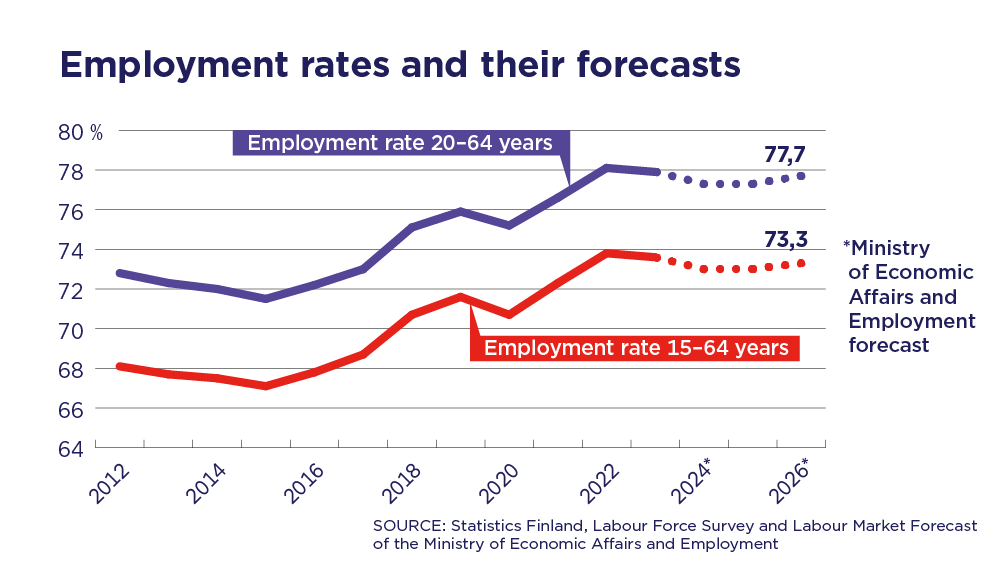Labour market forecast: A turn for the better can be expected towards the end of 2024

According to this spring’s short-term labour market forecast, unemployment growth is about to peak. Long-term unemployment is projected to increase throughout the year.
Weak economic development is reflected in the declining demand for labour. The number of open vacancies has fallen by more than half since the end of the coronavirus crisis.
The employment rate is expected to decline this year, but the number of employed people will not begin to fall because of strong immigration. Due to the favourable economic trend and immigration, the number of employed persons will grow by 16,000 in 2025, and by another 29,000 in 2026.
The employment rate of the working-age population (15-64-year-olds) will shrink by 0.6 percentage points to 73.0 per cent this year and decrease further by 0.1 percentage points in 2025. However, the employment rate will grow by 0.3 percentage points in 2026 to reach 73.3 per cent.
The unemployment rate is expected to increase by 0.5 percentage points this year. The unemployment rate is projected to hover around 7.7 per cent this year, fall to 7.5 per cent next year and to 7.1 per cent in 2026.
In 2024, the average number of unemployed jobseekers is estimated to be 277,000, which is 17,000 more than in 2023. Their number is expected to decrease to 269,000 in 2025, and to 267,000 in 2026.
The number of people unemployed in the long term will reach its peak towards the end of 2024, after which long-term unemployment will start to decline slowly. It is expected that there will be 93,000 long-term unemployed people in 2024, and that their number will decrease to 91,000 in the following year and to 88,000 in 2026.
Construction sector still in difficulties – lay-offs in manufacturing have helped to save jobs
The economic downturn has been most visible in the construction sector, where employment has fallen since the beginning of 2023 and is now at its lowest point in 25 years. According to the labour market forecast, nearly 15,000 more jobs will be lost in the construction sector this year, compared with last year. The situation will begin to improve towards the end of 2025, with the positive trend expected to continue in 2026.
To adapt to the downturn, the manufacturing sector has introduced large-scale lay-offs, which has helped to save jobs. Trends that will boost employment in manufacturing are also visible. The risk of fluctuations in the energy prices has decreased, but it is still significantly higher than before Russia’s invasion of Ukraine. The labour market forecast shows that the number of people employed in manufacturing in 2024 will fall by only a few thousand from 2023. Modest employment growth can be detected in manufacturing already in the coming years.
What is the labour market forecast?
The short-term labour market forecast of the Ministry of Economic Affairs and Employment is based on a statistical time-series analysis. It makes use of Statistics Finland’s Labour Force Survey, unemployment statistics, national accounts statistics, demographic statistics and the Ministry of Finance’s economic forecast. The forecast is published twice a year.
The labour market forecast for spring 2024 is based on the Ministry of Finance’s economic forecast, according to which GDP growth will come to a halt this year. However, growth will pick up again next year, with GDP estimated to increase by 1.6 per cent and by 1.5 per cent in 2026.
Inquiries:
Liisa Larja, Senior Specialist, Ministry of Economic Affairs and Employment, tel. +358 50 400 7352 (demand for labour, employment, population)
Minna Ylikännö, Chief Specialist, Ministry of Economic Affairs and Employment, tel. +358 295 047 102 (supply of labour, population)
Juho Peltonen, Senior Specialist, Ministry of Economic Affairs and Employment, tel. +358 295 047 119 (unemployment and immigration)